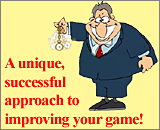|
Doubles backgammon is a great game ... so great that you will see it at most live tournaments around the world. The rules are simple: there are two players on a team, and they consult on every play and cube decision.
Often a stronger player teams up with a weaker player, and if there is a disagreement on what play to make, the team generally makes the play that the stronger player recommends.
But what if the two players are of about equal skill? Often, discussions, and even arguments go on far too long, and the more stubborn player wins. And then, when one player makes his move, if it doesn't go well, the other player never lets him forget it. If you want a formula for ending a marriage or friendship, I recommend you play doubles backgammon. I've played bridge, and believe me, this is worse.
So I came up with a solution that I use with my partners, and it pretty much solves the problem. If we disagree about a play, we discuss it briefly and see if one of us can convince the other to change his mind. If we still disagree, we "bid" for the move.
We take a picture of the position or record it, and then, I will say, "We will make my move, but I will pay you $5 if my move is wrong." Then my partner can accept my terms, or he can bid $10. And I can then accept his, or raise the bid until one of us gives up. Then we make the highest bidder's move.
This speeds up the game; allows each player to demonstrate how strongly he feels about his play; and rewards the player who had the better move if and when he is forced to make a wrong play by his partner.
After the match, we put the play (or cube decision) into Snowie and see who was right. If we made my partner's play, and it was right, that's great ... I'm happy. But if he was wrong, at least I got some compensation for it.
To me, the most important aspect of this procedure is the learning experience. By recording the position, betting on it, and running it in Snowie, I am much more likely to remember this lesson. The more lessons you learn, the more reference positions you have, and the better you will play. It's a great, fun way to play doubles and to learn.
(By the way, in all of our bets on plays and cubes decisions, we use the "Jake Jacobs" parameters. We put it in Snowie and do a 3-ply evaluation. If the difference between the plays is greater than .020, the bet is settled. If it is less than .020, we do a mini-rollout, 108 games, and that settles the bet. If it is still under .020, we call it a tie. If it is a bear-off play, we do a rollout every time, as we do not trust Snowie's 3-ply evaluation for bear-offs without a rollout.)
|

